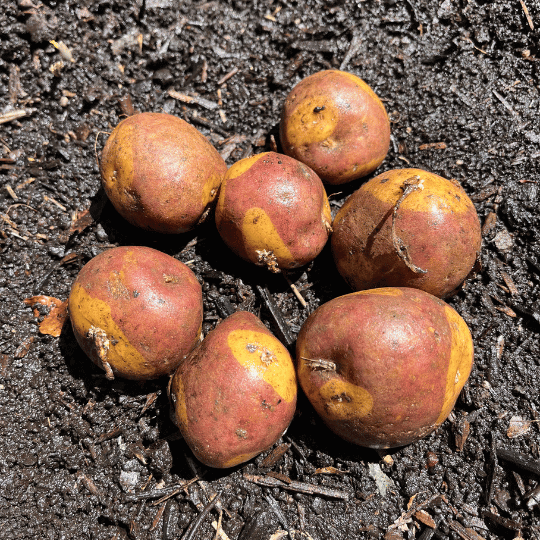Prep Beds
Thoroughly weed your garden bed to avoid competition with seedlings. Shape the bed and tidy up edging. Establish where you will be walking and accessing your crops by adding pavers, stones, or planks to indicate the path. Roots need oxygen, so gently aerate the soil with a garden fork or broad fork. No need to flip the soil; flipping or stirring the soil will destroy soil structure.
Add
compost and/or leaf mold to help build nutrient content and soil tilth ahead of plantings. Level the bed with a hard rake or bed rake and gently pack the surface ahead of sowings/transplants. Read more about prepping beds
here.
Direct Sow
As soon as frost is no longer a threat, the planting possibilities are endless. You can direct sow beans, beets, broccoli, cabbage, carrots, chard, corn, cucumbers, fennel, kale and collards, kohlrabi, lettuce, melons and watermelons, potatoes, radishes, scallions, spinach, summer squash, turnips and rutabagas, and winter squash. And don't forget your tender herbs like basil and parsley and your summer flowers! See
this post on supporting the pollinators through the entire growing season. Direct-sown seeds have different needs for spacing and depth of planting depending on the variety, but all of them like good drainage and a steady supply of moisture. For more tips on direct sowing, read
this post.
Seeds to Direct Sow After Last FrostPlant Potatoes & Dahlias
Wait until the soil has warmed up to plant Potatoes and Dahlias. Read up on potato-growing in this list of tips from Upstate potato grower Catherine Bennett. Generally, you'll want to plant dahlia tubers around the same time that you plant tomatoes.
Plant dahlias tubers in a sunny location with fertile, well-drained soil. The tubers should be planted parallel to the soil line (so, sideways rather than straight down) with the crown shoots pointing up. Water your dahlia tubers to keep the soil just moderately moist, since wet soil will make the tubers rot, and watch for slug damage. Stake dahlias once they establish.
Hardening Off
Hardening off indoor-grown plants is an oft-overlooked planting step that's helps to reduce transplant shock and acclimatizes plants to outdoor conditions. Harden off seedlings by gradually introducing them to outdoor conditions over the span of a week: Begin by setting plants in a sheltered location outdoors for just an hour or two the first day, working up to a full day by the end of the week. Eventually they will be sturdy enough to withstand nighttime temperatures as well, at which point they can be transplanted. For most plants, hardening off for around one week is sufficient.
Learn more details about hardening off here.
Transplanting
Making sure a late frost isn't going to sneak up on you is crucial here. Hoops and row cover can help protect them from unseasonable cold. Pick a mild, cloudy afternoon to give your seedlings a smooth transition. Use a Hand Trowel or Hori Hori to dig a spot for them, remove them carefully from their containers, and place them at soil level. Gently pat down the ground around them to ensure proper contact between soil and roots. (Tomatoes can actually be planted deeper than other seedlings. To read up on tomato transplanting specifically, click here.) Our Transplanting and Troubleshooting Guide can tell you more.
Because their roots systems are not yet established, transplants require frequent, but shallow watering at first. Don’t expect spring rains to do all the work. As plants mature, the inverse will be true: less frequent, but deeper watering is best. For more about watering, read this post.
Mulch
To mulch or not to mulch? For many gardeners, adding a layer of straw or other organic mulch right after direct sowing and transplanting is routine. If you are planting potatoes, mulch can be a great option right now. But for other crops, mulching early means blocking sunlight, which prevents the soil from warming up; add spring rains and this creates an ideal habitat for slugs. In midsummer, after the soil has had a chance to warm and the seedlings to grow, mulch helps regulate moisture and suppresses weeds.
Mulch is best for larger, vinier plants like tomatoes, eggplants, and squashes. This month, however, consider staying away from mulches like straw, or, if you do decide to use it now, create clear lines alongside your seedlings and furrows, not on top of them. If you're looking for a good alternative to protect your veggies from the elements, consider hoops and row cover.
More May Tips
- Succession sow radishes, carrots, beets, and greens this month.
- After hardening off tomatoes, add cages or other supports.
- Promote a bushier habit for flowering plants by pinching back early.
- Add peony cages before it’s too late.
- Add mulch around trees and shrubs.
- Feed your roses.
- Divide summer- and fall-flowering perennials.
- Harvest rhubarb stalks and make a pie!








